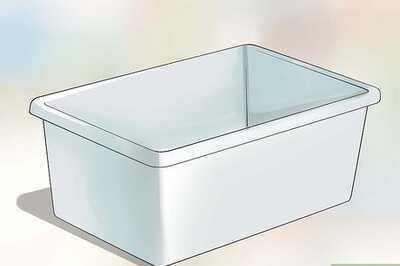
views
The World Cup stadium was designed to leave as little of an imprint on the Qatari sand as possible. It is now scheduled to be demolished.
The Qataris say the stadium will be demolished, but no date has been set. The Gulf country will soon host the Asian Cup, the multi-sport Asian Games, and possibly the Olympics.
A look at FIFA’s World Cup stadium requirements and what happens next for Qatar’s venues, according to a report by Associated Press.
What Qatar Required
FIFA has specific requirements for a World Cup host’s venue plan.
A main stadium with a capacity of at least 80,000 people to host the final, at least one more with a capacity of 60,000 to host a semifinal, and several more with a capacity of at least 40,000 — though FIFA allowed Russia to have two with capacities of less than 35,000 four years ago.
When Qatar bid for and won the hosting rights in 2010, it had a 12-stadium plan.
That project plan was reduced to eight stadiums about three years into its lengthy preparations for the 2022 tournament. Seven of them were built from the ground up, and the Khalifa International Stadium was renovated in preparation for the 2019 World Track and Field Championships.
FIFA agreed because Qatari soccer did not require so many new venues. Qatar did not require such large venues for its domestic games in the 12-team Qatar Stars League, where crowds of a few thousand are typical.
The long-term promise made during bidding was to remove one tier from some venues following the tournament. The steel and seats would be given to less-affluent countries in need of stadium infrastructure.
What Was the Cost?
The cost of Qatar’s stadiums is unknown. The total cost of projects related to World Cup preparations is estimated to be around $200 billion.
For its money, Qatar received seven new and distinct arenas with strong themes based on local culture.
The 89,000-seat Lusail Stadium is modelled after a hand-crafted bowl; the 69,000-seat Al Bayt Stadium is modelled after a nomad’s desert tent; and the Al Thumama Stadium is modelled after a woven cap.
The late Zaha Hadid, the world’s most famous female architect at the time, is said to have been inspired by the sails of a pearl fishing boat when designing Al Janoub Stadium. The sweeping curves of its roof were seen as feminine by many observers.
Human Rights Allegations
Tens of thousands of migrant workers, mostly from South Asia, were brought in to work in the conditions that have sparked the most controversy during this World Cup.
The exact number of workers killed or injured on tournament-related projects is unknown, in part because Qatar did not collect data or investigate the deaths.
Qatar reformed the kafala system, which tied workers to their employers, including European construction firms, and established a monthly minimum wage of 1,000 Qatari riyals ($275).
However, human rights activists claim that Qatar’s laws are not strictly enforced.
FIFA has shown some reluctance to establish a compensation fund for the families of deceased and injured migrant workers.
The Qatari government has dismissed the calls as a publicity stunt, emphasising its own efforts to ensure workers receive their unpaid wages.
Future Plans
Much of the detail, such as where the stadium parts will go, is unknown, but several will be scaled back.
According to Qatari World Cup organisers, Lusail Stadium will include “a community space of schools, shops, cafés, sporting facilities, and health clinics.” There will be a five-star hotel, a shopping mall, and a sports medicine clinic at Al Bayt.
Local soccer clubs will use two of the stadiums. Al Rayyan will play at Ahmad bin Ali Stadium, while Al Wakrah will play at Al Janoub.
The Qatar national team should continue to play at Khalifa International Stadium, including in World Cup qualifying games in 2026.
Asian Cup
Some of the stadiums will be repurposed for the next Asian Cup, which will be held in January 2024.
Qatar officially took over the hosting rights one month before the World Cup began, replacing China, which cited the COVID-19 pandemic as the reason for cancelling the tournament scheduled for June 2023.
Perhaps Stadium 974 will be spared for the Asian Championship, which begins in 13 months? The venue was built in the Doha Port area in a Lego-like design using the same number of shipping containers as Qatar’s international phone code.
Qatar also requires venues for the 2030 Asian Games, a multi-sport competition with more athletes competing than the Olympics.
Then there’s the big Olympic prize: hosting the Summer Games as early as 2036.
With inputs from the Associated Press
Read all the Latest Explainers here



















Comments
0 comment